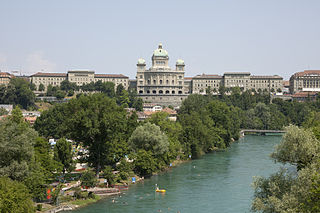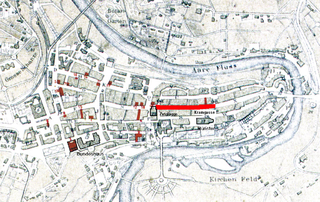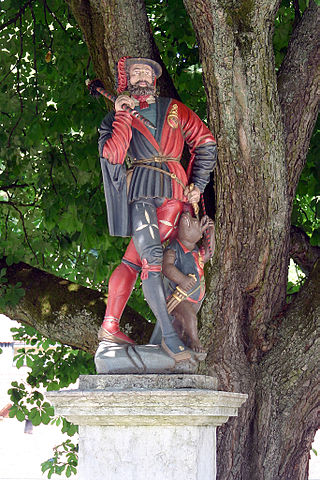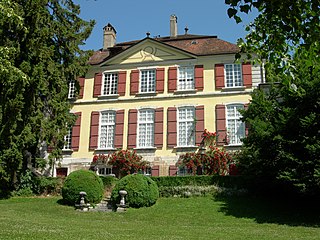On 26 June 1964, Swiss Post introduced postal codes as the third country after Germany (1941) and the United States (1963).

The Federal Palace is a building in Bern housing the Swiss Federal Assembly (legislature) and the Federal Council (executive). It is the seat of the government of Switzerland and parliament of the country. The building is a listed symmetrical complex just over 300 metres (980 ft) long. It is considered one of the most important historic buildings in the country and listed in the Swiss Inventory of Cultural Assets of National Importance. It consists of three interconnected buildings in the southwest of Bern's old city. The two chambers of the Federal Assembly, the National Council and Council of States, meet in the parliament building on Bundesplatz.

The Untertorbrücke is a stone arch bridge that spans the Aare at the easternmost point of the Enge peninsula in the city of Bern, Switzerland, connecting the Mattequartier in the Old City to the Schosshalde neighbourhood. Built in its current form in 1461–89, it is the oldest of Bern's Aare bridges, and was the city's only bridge up until the middle of the 19th century. It is a Swiss heritage site of national significance.

Diplomatic relations between Switzerland and the United States were established in 1853 by the U.S. and in 1868 by Switzerland. The first diplomatic representation of the U.S. was established in Basel in 1853.
The Society for Art History in Switzerland is a Swiss learned society dedicated to promoting the understanding of Swiss art history and particularly of Swiss topography of art, including the study and maintenance of Swiss cultural heritage sites. The society, founded in 1880, publishes a wide range of monographs, guides, and inventories. These include the series Art monuments of Switzerland, which includes more than one hundred volumes, the first of which was published in 1927. It also publishes the quarterly journal Kunst und Architektur in der Schweiz.

The Kramgasse is one of the principal streets in the Old City of Bern, the medieval city centre of Bern, Switzerland. It was the center of urban life in Bern until the 19th century. Today, it is a popular shopping street. Its length, slight curve and long line of Baroque façades combine to produce Bern's most impressive streetscape.

The Junkerngasse is a street in the Old City of Bern, the medieval city center of Bern, Switzerland. It connects the tip of the Aar peninsula to the Münster.

The Swiss Northeastern Railway was an early railway company in Switzerland. It also operated shipping on Lake Constance (Bodensee) and Lake Zürich. Until the merger of the Western Swiss Railways into the Jura–Simplon Railway (JS) in 1890/91, it was the largest Swiss railway company.

The Läuferbrunnen is a fountain on Läuferplatz in the Old City of Bern, Switzerland. It is a Swiss Cultural Property of National Significance and is part of the UNESCO World Heritage Site of the Old City of Bern.

Blumenstein Castle is an estate house in the municipality of Solothurn of the Canton of Solothurn in Switzerland. It is a Swiss heritage site of national significance. In 1952 it became the home of the Historical Museum of Solothurn.

Gümligen Castle is a castle in the municipality of Muri bei Bern of the Canton of Bern in Switzerland. It is a Swiss heritage site of national significance.

Obere Burg, also known colloquially as Burg Neu-Schellenberg, is a castle ruin located in the municipality of Schellenberg, Liechtenstein. It lies at the western edge of Hinterschloss, one of the burroughs in the village of Neu-Schellenberg. It is freely open to tourists. Due to its close proximity to Hinterschloss, it is probably the most easily accessible of all Liechtenstein castles. Obere Burg is one of the five existing castles in Liechtenstein and one of the three ruined ones in the country.

Gutenberg Castle is an intact castle in the town of Balzers, Liechtenstein, in the centre of the municipality of Balzers, the southern-most municipality in the country. Gutenberg is one of the five castles of the principality and one of two that have survived intact until the present day.

Baden railway station serves the municipality of Baden, in the canton of Aargau, Switzerland. Opened in 1847, it is owned and operated by SBB-CFF-FFS.

The Embassy of the United States in Bern manages the official relationship between the United States and the Swiss Confederation and the Principality of Liechtenstein. The diplomatic mission of the United States was established in April 1853 as a legation, and was elevated to an embassy in 1953. Within the Embassy, several U.S. agencies are represented, including the Department of State, Department of Defense, Department of Commerce, and Department of Justice. The mission aims to foster strong bilateral ties and advance U.S. policy objectives in Europe. It also provides services such as visa issuance and emergency assistance to Americans in Switzerland.

The Swiss Journal of Economics and Statistics is an open access peer-reviewed academic journal of economics, published by SpringerOpen on behalf of the Swiss Society of Economics and Statistics, and financially supported by the Swiss Academy of Humanities and Social Sciences and the Swiss National Bank. The current editor-in-chief is Marius Brülhart.
















